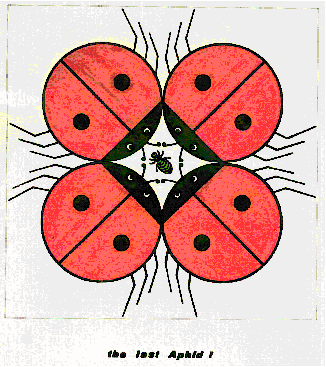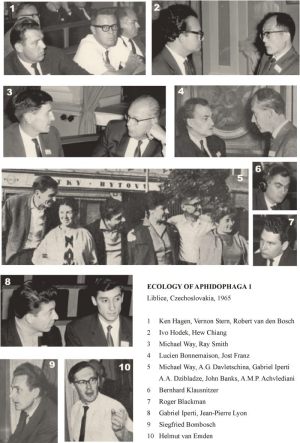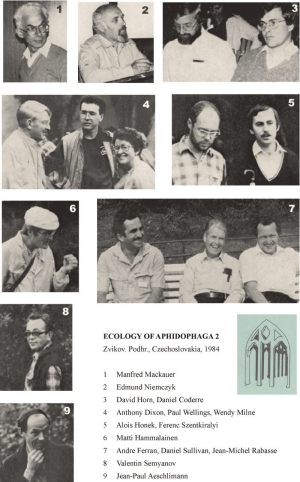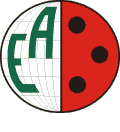Ecology of Aphidophaga
International symposia on the research into behaviour and ecology of aphidophagous insects
ECOLOGY OF APHIDOPHAGA - EARLY HISTORY
After the era of great hopes in insecticides, the 50s brought a return to the interest in entomophagous insects. The authors of the concept of integrated control (based on the research on aphid pests on alfalfa and published in California in 1959; see Ken Hagen's bibliography), Ray F. Smith, Vernon M. Stern, Robert van den Bosch and Kenneth Hagen, realized the fundamental contrast between the impact of coccidophagous and aphidophagous insects on the population dynamics of their preys. It has become clear that the expectations arisen from the success with the introduction of Rodolia cardinalis did not take into consideration the principal difference in the prey-predator relation between coccidophagous and aphidophagous coccinellids. This difference has been neglected, although it has long been well known that, among several important factors (e.g. synchronisation), one is decisive for the prey-predator relation: The ratio between the annual number of generations of the predator and its prey. In case of R. cardinalis and Icerya purchasi, the ratio is about 1 : 3 in favour of the predator: R. cardinalis has roughly 3 generations to one of the prey. ( In citrus groves in Israel and California, the ratio is similar: the scale insect has 4 gen/yr, the coccinellid 12 gen/yr.) In contrast, the aphid eating ladybird Hippodamia quinquesignata is usually bivoltine, while the aphid Therioaphis trifolii may have up to 35 gen/yr in California. Even if we calculated with an unusually high number of 4 gen/yr for the coccinellid and only 20 gen/yr for the prey, the ratio would be 5:1 in favour of the aphid.
Together with colleagues from Britain (Michael Way, John Banks
and Helmut van Emden),
France (Lucien Bonnemaison and Gabriel Iperti), and Germany (Siegfried
Bombosch), we all
shared the view that the case of aphids, particularly on annual crops,
would need a long and very
detailed study of ecology and behaviour of their natural enemies. As it
was hoped that
international exchange of experience and views could foster the
progress in the field, several
people adviced to organise a meeting. The European specialists were
invited by Bombosch to
Goettingen in March 1965 , and they decided there to take part in a
symposium "Ecology of
Aphidophagous Insects" in Czechoslovakia, that was intended to have a
worldwide scope, in
particular involving also the researchers from California and Canada.
Our country was chosen
for two reasons. (1) At that time, it was difficult for scientists from
the "eastern camp" to travel
to the "west", but relatively easy for the colleagues from the "west"
to visit the "eastern"
countries. In the relatively liberal period in mid 60s an "opening to
the world" even took place
and the idea of an international meeting in Czechoslovakia was
supported. (2) In the Academy
of Sciences in Prague, there was an active team of 4 young workers
studying aphids (J. Holman),
coccinellids (I. Hodek), aphid parasites (P. Stary) and chrysopids (J.
Zeleny). Their earliest paper
appeared in 1954 and a booklet "Natural Enemies of Aphis fabae"
was in press. A specialist on
syrphids and Heteroptera, P. Stys from the Charles University also
joined the team.
The symposium took place at Liblice, a small castle then belonging to the Academy, and both the lectures and discussion were simultaneously translated from and to four languages!!! There were 56 participants from 17 foreign countries (plus 16 from Czechoslovakia). Several first-rank specialists arrived, who unfortunately are no longer among us, and some of them have become almost mythical personalities (Plate 1): L. Bonnemaison and J.P. Lyon (France), D. Hille Ris Lambers and H.J. de Fluiter (The Netherlands), B. Galecka (Poland), J. Banks and J.S. Kennedy (UK), R.v.d. Bosch and K. Hagen (USA), V.V. Yakhontov (USSR-Uzbekistan). Apart from those deceased colleagues mentioned above, the meeting was attended also by other leading specialists who have since retired, such as Hew Chiang (USA) or Gabriel Iperti (France). Others are still active, although they are emeriti (Tony Dixon, Helmut van Emden, Michael Way from UK). As a student with Michael Way, Roger Blackman, a recent leading aphidologist, joined us as well. The symposium was a success and the Proceedings (1966; all lectures translated to English) have since been often cited. I would like to believe that this event - similarly to the subsequent meetings - helped the progress in the field. To show that the comments expressed almost 40 years ago may still be useful, I am joining copies of several pages by Ray F. Smith.
In 1965, some promises were made during the farewell party and thus we hoped to meet again after a short period again. However, nothing happened - for a long period of 19 years!
Three years after the symposium, our country went through
great and unpleasant changes - after
the "friendly help" of Soviet tanks. For several years I had thus other
problems than to remind
colleagues of their promises. On the contrary, around 1980 several of
them asked me again to
convene the second meeting, which I did. In the meantime our Institute
was transferred from
Prague to Ceske Budejovice and thus the meeting was held in southern
Bohemia about halfway
between the two towns, in a hotel at Zvikovske Podhradi, near a gothic
castle (logo of the
meeting) (Plate 2). To provide an overview of
further developments, two
tables follow that
summarize the participation and sites
of the subsequent symposia and
also bibliographic data on
the Proceedings.
August 2004, I. Hodek


